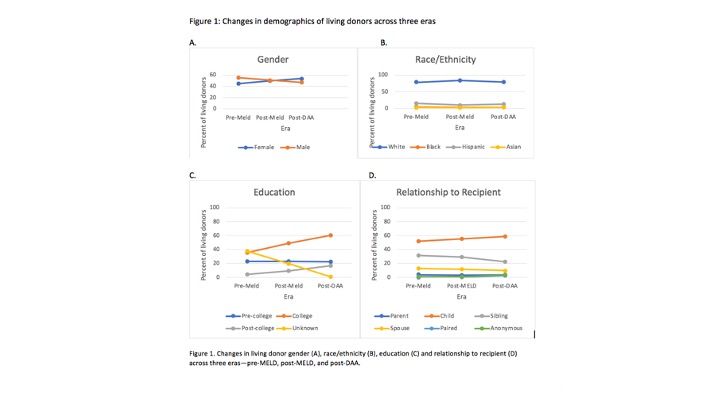Trends in Liver Donors for Liver Transplantation Over Twenty Years: Donor Changes in Gender, Relationships, and Education, but Racial Disparities Remain
Gastroenterology and Hepatology, New York Presbyterian/Weill Cornell, New York, NY
Meeting: 2021 American Transplant Congress
Abstract number: 38
Keywords: Donation, Living donor
Topic: Clinical Science » Liver » Liver: Living Donor Liver Transplant and Partial Grafts
Session Information
Session Name: Living Donor Liver Transplant and Partial Grafts
Session Type: Rapid Fire Oral Abstract
Date: Saturday, June 5, 2021
Session Time: 4:30pm-5:30pm
 Presentation Time: 4:45pm-4:50pm
Presentation Time: 4:45pm-4:50pm
Location: Virtual
*Purpose: Living donor liver transplant (LDLT) has grown over the past several decades as a response to critical organ shortages. Racial and ethnic disparities exist in recipients of liver transplant but have not been studied in the living donor population. We thus examined demographic changes in living donors over time.
*Methods: Adult living donors who donated to adults were identified from 1998-2018 using the United Network for Organ Sharing (UNOS) database. Annual trends as well as trends across three eras were analyzed: pre-MELD (Model for End-Stage Liver Disease) (1998-2002), post-MELD (2003-2014), and post-DAA (Direct-acting antivirals) (2015-2018). The primary outcomes of interest were to examine demographic changes over time in living donors with regard to gender, race/ethnicity, education, and relationship. Annual trends were compared using annual percent change (APC), while comparisons across the time periods were assessed using chi-squared test.
*Results: There were 4,769 LDLTs (4.25% of all transplants) between 1998 and 2018. While initially men donated more (55% in the pre-MELD era), the percentage of female donors increased annually (APC 0.9%, 95% CI 0.4-1.4) and ultimately comprised 53% in the post-DAA era. There were no significant changes over time with regard to race/ethnicity of donors; however, Whites made up a significant majority of living donors across all time periods (p<0.001). The percentage of Black donors remained low—4.5% in pre-MELD and falling to only 3% in post-DAA era. Of those with documented education, there was a significant change in education level over time, with increasing percentages of donors with higher education levels (APC 3.7%, 95% CI 2.9-4.4 for college and APC 8.6%, 95% CI 7.1-10.2 for post-college)—77% of living donors had college education or above in post-MELD era. Lastly, there was a significant change over time in donors’ relationships to recipients with increasing percentages of child, paired, and anonymous donations while decreasing percentages of sibling and spouse donations (p<0.001).
*Conclusions: Female and highly educated living donors are increasingly common and now represent the majority of donors for LDLT. Blacks appear underrepresented in living donation and this disparity has persisted for the last 20 years. Through future, prospective research, it will be important to understand why these disparities exist so that targeted efforts can be made to increase outreach and close the gap between organ supply and demand.
To cite this abstract in AMA style:
Kaplan A, Fortune B, Brown R, Samstein B, Halazun K, Rosenblatt R. Trends in Liver Donors for Liver Transplantation Over Twenty Years: Donor Changes in Gender, Relationships, and Education, but Racial Disparities Remain [abstract]. Am J Transplant. 2021; 21 (suppl 3). https://atcmeetingabstracts.com/abstract/trends-in-liver-donors-for-liver-transplantation-over-twenty-years-donor-changes-in-gender-relationships-and-education-but-racial-disparities-remain/. Accessed December 27, 2025.« Back to 2021 American Transplant Congress

